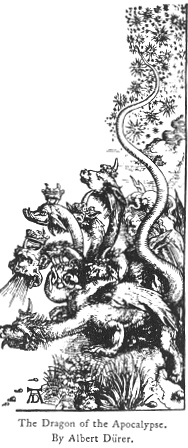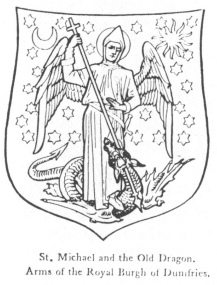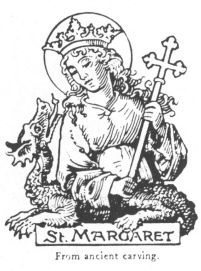
Sacred Texts Legendary Creatures Symbolism Index Previous Next
Buy this Book at Amazon.com


Fictitious and Symbolic Creatures in Art, by John Vinycomb, [1909], at sacred-texts.com
(The symbol of the Supreme Spirit of Evil, or the Evil One)
It was believed that in the gloomy land of the Cimmerians and the confines of Hades strange monsters were to be met; and not only there, but in any part of the universe which was conceived to be
beyond the pale of human habitation these weird creatures might be encountered. The same idea is recognised in the Semitic belief, that uncanny beings lurked in the outer deserts, where men did not penetrate at all, or did so only at great danger. The "place of dragons" is associated with "the shadow of death" (Ps. xliv. 19). Dragons are also associated with the waters of the deep (Ps. lxxiv. 13) and are called upon to praise Jehovah (Ps. cxlviii. 7); and Isaiah (xxxiv.), describing in vivid and picturesque language the destruction and utter desolation which shall come on Zion's enemies, prophesies that her palaces and fortresses "shall be a habitation for dragons."
The term dragon is applied by the translators of the Scriptures to some monsters of which we have no knowledge. The word is used by ecclesiastics of the Middle Ages as the symbol of sin in general and paganism in particular, though ofttimes heresy is denoted. The metaphor is derived from Rev. xii. 9, where Satan is termed the Great Dragon; in Psalm xci. 13, it is said "the saints shall trample the dragon under their feet."
In the book of Job we recognise in Leviathan a creature more like the extinct saurians of the old world than any crocodile recorded in historic times; and this leviathan is treated as still existing in the days of David. In Psalm lxxiv. 13, 14, Jehovah is spoken of as having broken the heads of the dragons in the waters; in Isaiah li. 9, as having
wounded the dragon; and pæans are sung on the punishment of "Leviathan, that crooked serpent," and the slaying of "the dragon that is in the sea" (Is. xxvii. 1). Finally, in the Apocalyptic
 |
As a Christian emblem the dragon may be taken to symbolise the supreme spirit of evil, a veritable devil whom it was the special mission of militant saints to slay, as it had been the glory of the heroes of the pagan mythology to conquer. "In pictures of sacred and legendary subjects," says a late writer, "the
dragon usually formed an important feature. The evil thing was invariably depicted writhing under the foot of the saint, or transfixed with his triumphant spear. In like manner the virtues trampled tranquilly each on her complementary vice, embodied in the form of some impossible creature; and if the rigid virtues were sometimes insipid, it must be allowed that the demons were usually grotesquely characteristic, and often delightful in colour."
The prostrate attitude usually signifies the triumph of Christianity over Paganism, as in pictures of St. George and St. Sylvester; or over heresy and schism,
 St. Michael and the Old Dragon. Arms of the Royal Burgh of Dumfries. |
the Archangel. The numerous legends of saints who have fought and overcome dragons prove the symbolic light in which the impersonation of evil was generally viewed.
 |
to her in the form of a horrible dragon and endeavoured to frighten her from her path. Margaret held up the cross and the dragon fled. Other legends say he burst asunder.